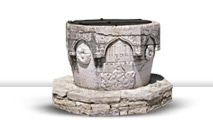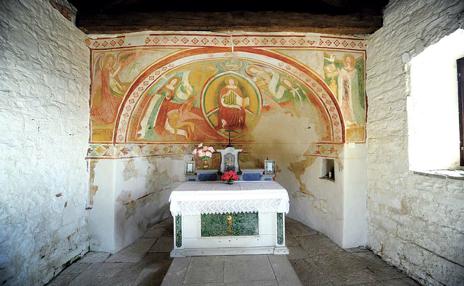
- Gradišće – Koper
- Podpeč – Zanigrad – Hrastovlje
- Slum – Roč – Hum
- Draguć – Paz – Gradinje – Gologorica
- Pićan – Gračišće – Lindar
- Pazin – Beram
- Oprtalj – Čirkoti – Rakotule
- Vižinada – Božje polje – Labinci
- Višnjan – Bačva – Poreč
- Sv. Lovreč – Kloštar
- Šorići – Dvigrad – Kanfanar
- Žminj – Svetvinčenat
- Bale – Batvači – Fažana – Pomer
- Bičići – Barban – Prodol
- Jasenovik – Nova Vas – Vranja
- Plomin – Brseč – Lovran
Oprtalj – Čirkoti – Rakotule
Oprtalj
St. Helen
Of the entirely painted interior of St. Helen’s Church, only the fresco of the Annunciation has been preserved. It stands on the triumphal arch, while in the half-dome vault of the apse is Christ in the mandorla surrounded by symbols of Four Evangelists and a round medallion with the resurrected lamb. To his left are St. Helen, and to the right most probably St. Nazarius, the bishop of Koper.
The palette of our painter was restricted to four primary colors: white, yellow, red and blue-green along with details painted in purple. Although the red color prevails, optically it is the blue-green, so typical of this painter that is dominant. By its pastel tone it creates an atmosphere of surreal and transcendental giving the painting certain softness. The plasticity is achieved by modeling the red on the light rosy complexion. The silhouette of the body is outlined by a thick line in order to separate the bodies from the background. The decorative quality is accentuated by an abundance of ornament in contrast to the two-dimensional flatness. There is a prevailing impression of stylized and geometrical tendency of the figures. Tube-like shapes are repeated in the modeling of the whole bodies as well as in the arms and pleats on the robes, and even angel wings. The present airiness of the painting is but an impression appearing due to the partial loss of pigment because it was applied in a thin layer. Details have faded so that some figures appear as ghosts. Details of anatomy and the portraits are typified, particularly the egg shaped, gentle, charming faces and the undulating stylized yellow hair.
The frescoes have until recently been attributed to the workshop of Klerigin from Koper, but have lately been more precisely attributed to the Furlanian workshop that existed in nearby Čirkoti.
Imprimer la page Envoyer a un ami

















